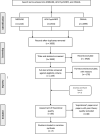A theoretical systematic review of patient involvement in health and social care education
- PMID: 35841446
- PMCID: PMC9992014
- DOI: 10.1007/s10459-022-10137-3
A theoretical systematic review of patient involvement in health and social care education
Abstract
Patient involvement in health and social care education lacks theoretical underpinning, despite increasing calls for rigour. Theories help explain how learning is advanced and offer guidance for how faculty work with patients who become involved in curriculum delivery. We conducted a systematic review to synthesise how theory shapes our understanding of patient involvement in health and social care education. Three databases were systematically searched. Studies demonstrating explicit and high-quality application of theory to patient involvement in teaching and learning or involvement within a community of health and social care educators, were included. A narrative synthesis was undertaken using Activity Theory as an analytical lens to highlight the multifaceted components of patient involvement in professional education. Seven high-quality, theoretically underpinned studies were included. Four studies applied theory to pedagogy, showing how deep learning from patient involvement occurred. Despite a growing body of studies which attempt to use theory to explain learning, many were descriptive, lacked theoretical quality and were therefore excluded. Three studies applied theory to illuminate the complexity of involving patients in the educational system, showing how patients can be supported and valued in teaching roles. This review highlights that more work is required to identify the mechanisms through which patient involvement enhances learning and, to explore what involvement within the education community means for faculty and patients. Our understandings of patient-educator partnerships for learning could be progressed by further high-quality theory driven studies, which include the patient voice.
Keywords: Patient involvement; Professional education; Systematic review; Theoretical quality.
© 2022. The Author(s).
Conflict of interest statement
The authors declare that they have no conflict of interest.
Figures
References
-
- Agrawal S, Kalocsai C, Capponi P, Kidd S, Ringsted C, Wiljer D, Soklaridis S. “It was great to break down the walls between patient and provider”: Liminality in a co-produced advisory course for psychiatry residents. Advances in Health Sciences Education. 2020;26(2):385–403. doi: 10.1007/s10459-020-09991-w. - DOI - PubMed
-
- Arnstein SR. A ladder of citizen participation. Journal of the American Institute of Planners. 1969;35(4):216–224. doi: 10.1080/01944366908977225. - DOI
-
- Basset T, Campbell P, Anderson J. Service user/survivor involvement in mental health training and education: Overcoming the barriers. Social Work Education. 2006;25(4):393–402. doi: 10.1080/02615470600593675. - DOI
-
- Beresford P, Croft S. Citizen involvement: A practical guide for change. Macmillan International Higher Education; 2016.
Publication types
MeSH terms
LinkOut - more resources
Full Text Sources



